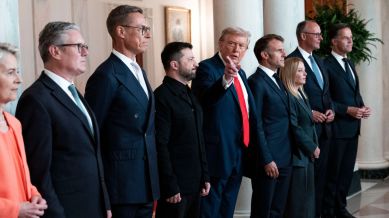Europe scrambles over US plan to end Ukraine war mostly on Russia’s terms
The plan, which Ukraine and Europe have said was drafted without their involvement, would require Ukraine to accept conditions that it and its European allies have long called unacceptable and tantamount to capitulation.

European leaders scrambled Friday to respond to a White House proposal to end the war in Ukraine, a 28-point document that would give Russia most of what it has asked for, including the surrender of Ukrainian territory and sharp limits on Ukraine’s military.
The plan, which Ukraine and Europe have said was drafted without their involvement, would require Ukraine to accept conditions that it and its European allies have long called unacceptable and tantamount to capitulation.
According to a draft posted online by a Ukrainian lawmaker, the proposal would require Ukraine to change its constitution to prohibit any effort to join NATO. It would force Ukraine to recognize Russian control of the eastern Donetsk and Luhansk regions, parts of which Ukraine still holds. And it would cap the size of the Ukrainian army at 600,000, down from an estimated current strength of more than 800,000.
The proposal would also bar the presence of NATO troops inside Ukraine, which would derail a European plan to help ensure the country’s postwar security.
If Ukraine agrees to end the war, the proposal says, it would be given frozen Russian assets to help pay for its reconstruction. Ukraine would also receive what the plan calls reliable security guarantees, promising a military response if Russia invaded again but offering few details.
If Moscow did invade again, the proposal says, sanctions would be reinstated and Moscow would lose benefits included in the agreement. Those sweeteners include major Russian goals like readmittance to the Group of 8, reintegration into the global economy and joint investment opportunities with the United States.
The plan was drafted by Steve Witkoff, a Trump administration envoy for peace missions, and Kirill Dmitriev, a Russian counterpart. The Kremlin has deflected questions about whether it supports the 28-point plan. President Volodymyr Zelenskyy of Ukraine said he would engage “constructively” with the proposal after meeting Thursday with a U.S. military delegation sent to Kyiv, the Ukrainian capital, to restart peace talks.
Stefan Kornelius, a spokesperson for Chancellor Friedrich Merz of Germany, said in a statement that Merz, President Emmanuel Macron of France and Prime Minister Keir Starmer of Britain had assured Zelenskyy during a call Friday of “their continued and full support on the path to a lasting and just peace.” The statement did not explicitly mention the U.S.-Russian plan.
On their call, the leaders welcomed the U.S. efforts to end the war but insisted on a need to protect “vital European and Ukrainian interests in the long term.”
“The Ukrainian armed forces must remain capable of effectively defending Ukraine’s sovereignty,” the statement said, adding that “any agreement affecting European states, the European Union, or NATO requires the consent of European partners or a consensus among allies.”
The 28-point plan is the latest effort by the Trump administration to revive stalled negotiations to end the war, which has lasted nearly four years since Russia launched a full-scale invasion of Ukraine in February 2022.
That effort comes at a delicate time for Ukraine. Zelenskyy’s administration is caught in a corruption scandal; the Ukrainian army is facing growing pressure on the battlefield; Russian airstrikes are battering Ukraine’s energy grid as winter approaches; and the civilian death toll is mounting.
Zelenskyy said after the call with the European leaders that Ukraine was “working on the document prepared by the American side” but he insisted that “this must be a plan that ensures a real and dignified peace.”
“We are coordinating closely to make sure that the principled stances are taken into account,” Zelenskyy said on social media.
The Trump administration is pursuing multiple streams of diplomacy to end the war in Ukraine, and it is still unclear how the proposed 28-point plan fits into the administration’s overall strategy. White House press secretary Karoline Leavitt said on Thursday that the plan was still in “flux.”
But Ukrainian and European officials have already balked at the reported terms of the U.S.-Russia peace plan, which would also forgo any role for a Western peacekeeping force after a ceasefire.
“If Ukraine accepts this, there will be no Ukraine anymore,” Marko Mihkelson, the chair of the Estonian parliament’s Foreign Affairs Committee, wrote on the social platform X. “If Europe accepts this, we must prepare for a direct war with Russia.”
Starmer said after arriving in South Africa for a Group of 20 meeting being held this weekend that “we all want a just and lasting peace.”
“That’s what the president of America wants. That’s what we all want. And so we need to work from where we are to that end,” he said. “But the principle that Ukraine must determine its future under its sovereignty is a fundamental principle.”
In Moscow, the Kremlin warned that Ukraine must enter into negotiations “now” or face losing more territory.
Speaking with journalists on Friday, Dmitry Peskov, President Vladimir Putin’s spokesperson, said that Zelenskyy’s “room for maneuver regarding decision-making is shrinking as territories are lost” to the Russian army.
“Continuing is senseless and dangerous for them,” Peskov said, referring to Ukrainian leadership.
But he declined to comment on the substance of the plan, saying Moscow was not prepared to conduct negotiations “in megaphone mode” and that the Kremlin remained “committed to the platform of discussions that took place in Anchorage,” referring to a meeting in August between President Donald Trump and Putin in Alaska.
“We are aware of the existence of possible modifications and approved wordings, but we have not received anything officially,” Peskov said.
This article originally appeared in The New York Times.